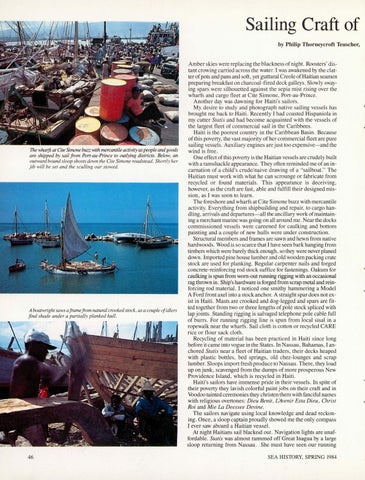Sailing Craft of by Philip Thorneycroft Teuscher,
The wharfs at Cite Simone buzz with mercantile activity as people and goods are shipped by sail from Port-au-Prince to outlying districts. Below, an outward bound sloop shosts down the Cite Simone roadstead. Shortly her jib will be set and the sculling oar stowed.
A boatwright saws a frame from natural crooked stock, as a couple of idlers find shade under a partially planked hull.
46
Amber slcies were replacing the blackness of night. Roosters' distant crowing carried across the water. I was awakened by the clatter of pots and pans and soft, yet guttural Creole of Haitian seamen preparing breakfast on charcoal-fired deck galleys. Slowly swaying spars were silhouetted against the sepia mist rising over the wharfs and cargo fleet at Cite Simone, Port-au-Prince. Another day was dawning for Haiti's sailors. My desire to study and photograph native sailing vessels has brought me back to Haiti. Recently I had coasted Hispaniola in my cutter Statis and had become acquainted with the vessels of the largest fleet of commercial sail in the Caribbees. Haiti is the poorest country in the Caribbean Basin. Because of this poverty, the vast majority of her commercial fleet are pure sailing vessels . Auxiliary engines are just too expensive-and the wind is free. One effect of this poverty is the Haitian vessels are crudely built with a ramshackle appearance. They often reminded me of an incarnation of a child's crude/naive drawing of a "sailboat." The Haitian must work with what he can scrounge or fabricate from recycled or found materials. This appearance is deceiving, however, as the craft are fast, able and fulfill their designed mission , as I was soon to learn . The foreshore and wharfs at Cite Simone buzz with mercantile activity. Everything from shipbuilding and repair, to cargo handling, arrivals and departures-all the ancillary work of maintaining a merchant marine was going on all around me. Near the docks commissioned vessels were careened for caullcing and bottom painting and a couple of new hulls were under construction. Structural members and frames are sawn and hewn from native hardwoods. Wood is so scarce that I have seen bark hanging from timbers which were barely thick enough , so they were never planed down. Imported pine house lumber and old wooden paclcing crate stock are used for planlcing. Regular carpenter nails and forged concrete-reinforcing rod stock suffice for fastenings. Oakum for caullcing is spun from worn-Out running rigging with an occasional rag thrown in. Ship's hardware is forged from scrap metal and reinforcing rod material. I noticed one smithy hammering a Model A Ford front axe! into a stock anchor. A straight spar does not exist in Haiti. Masts are crooked and dog-legged and spars are fitted together from two or three lengths of pole stock spliced with lap joints. Standing rigging is salvaged telephone pole cable full of burrs. For running rigging line is spun from local sisal in a ropewalk near the wharfs. Sail cloth is cotton or recycled CARE rice or flour sack cloth . Recycling of material has been practiced in Haiti since long before it came into vogue in the States. In Nassau , Bahamas, I anchored Statis near a fleet of Haitian traders, their decks heaped with plastic bottles, bed springs, old chez-lounges and scrap lumber. Sloops import fresh produce to Nassau. There, they load up on junk, scavenged from the dumps of more prosperous New Providence Island, which is recycled in Haiti. Haiti's sailors have immense pride in their vessels. In spite of their poverty they lavish colorful paint jobs on their craft and in Voodoo tainted ceremonies they christen them with fanciful names with religious overtones: Dieu Benit, Llvenir Esta Dieu, Christ Roi and Mie La Deessee Devine. The sailors navigate using local knowledge and dead reckoning. Once, a sloop captain proudly showed me the only compass I ever saw aboard a Haitian ve:ssel. At night Haitians sail blacke<d out. Navigation lights are unaffordable. Statis was almost rarmmed off Great lnagua by a large sloop returning from Nassau. , She must have seen our running SEA HISTORY, SPRING 1984
